Students blend science with Native perspectives
by LJ Evans, University Relations
October 2005
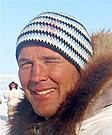
"This bridge of the two worlds of science is a wonderful place."
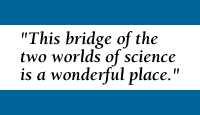
"It showed me a nationwide network of Native students in fields of medicine, engineering and science. It gave me a home 'mission' by providing a forum to encourage others in similar fields. Why should math and science classes be things that Alaska Natives or anyone barely passes to get on with a four-year degree? Why can't these classes be something we excel at? Seeing the spiritual side of the nationwide AISES leadership was also a very moving experience for me and again echoed the connection between the 'two worlds' of science and the Native perspective."
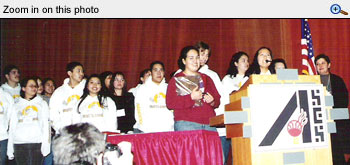
At the first meeting of the chapter for the 2005-06 academic year Sept. 8, co-presidents Kelly Thompson and Ann Wilson introduced themselves and explained why being a member of AISES could benefit the 30 or so other students present.
"I joined AISES at first because it was a good place to meet people here on campus," said Wilson, a senior majoring in biochemistry.
"But when I went to the annual conference I saw that AISES is a place to meet people, present your work and advance yourself in the sciences on a national scale, and it's also a way to keep connected with a Native way of life," Wilson said. "The speakers and opportunities that AISES provides are great. It also allows me to meet people with the same goals I have and we are able help one another."
Thompson, a senior majoring in electrical engineering said, "I'm involved in AISES because it is a great way for me to stay motivated as it gets later in the semester. I enjoy the meetings because they are another chance to catch up with the friends I've made through AISES. Also, hearing from our guest speakers about exciting research and job opportunities keeps me focused on the fruition of all my long hours of study."
"It's easy as you get into the middle of a semester to think, 'man, this stuff is a pain.' It helps to remember what you're going through all the trouble for," Thompson said. "Having contact with so many positive role models through involvement with the group really works to keep motivated."
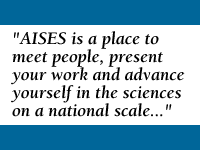
Glenn said "If I had to guess about the year we started AISES at UAF it would be sometime around 1986 or 1987."
"I saw a flier gauging interest for an AISES chapter at UAF. I looked at the name of the organization and thought about all the good work that was going on inside Rural Student Services at the time," Glenn said. "Whether math and science was the focus of a major or just prerequisite classes toward another degree, there were many Alaska Native students in RSS plugging away at engineering, physics, calculus, geology and other technical classes. I was tutoring undergraduate students through these types of classes and professors like John Kelley of the Institute of Marine Science were always encouraging young Native students to consider a math, science or engineering field. And there were a handful of Alaska Natives around Alaska and in UAF who had already completed technical degrees. What they needed was a place to encourage others. So, when I saw the flier about starting an AISES chapter at UAF, it fit right in with my own vision."
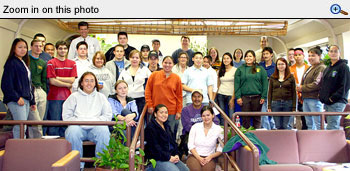
Five or 10 students gathered at the initial meeting and decided to form a chapter. "I was elected the first president," Glenn said, "so I jokingly call myself the 'George Washington' of the UAF AISES group."
The chapter has grown in members and confidence since those early days under the guidance of chapter advisor Sue McHenry, an academic advisor in RSS; and Greg Owens, faculty advsior for the chapter and associate professor of mathematics. The students benefit through membership in the organization but they also give back. AISES members tutor other students in math, physics and engineering several hours a week throughout the semester. They compile the chapter's lengthy annual report for the national AISES meeting, serve on scholarship and travel grant committees, send out letters soliciting funds, organize speakers for meetings and meet with high school student groups who visit campus throughout the year to tell them what it's like to be a student at UAF.
"A very big example will be when the Alaska Federation of Natives comes to Fairbanks in October," McHenry said. "The first half of the AFN conference is focused on youth and elders, and AISES students will participate in discussions with high school students about the challenges of college."
One important aspect of chapter activities is helping students find summer jobs and internships that are relevant to their science and technology career aspirations. As they went around the room at the first chapter meeting of the semester, students told how they spent the summer of 2005 working at jobs or internships with organizations such as IBM, Alyeska, Experimental Program to Stimulate Competitive Research, Rural Alaska Honors Institute, ABR, ORION, the Alaska Department of Fish and Game, the U.S. Fish and Wildlife Service, Alaska INBRE: Alaska IDeA Networks of Biomedical Research Excellence, Harvard Medical School, the Alaska Native Tribal Health Consortium, Stanford Medical Center, UAF's Geophysical Institute and Design Alaska in Fairbanks. The students worked in a wide array of scientific fields such as biomedical engineering and marine ecology, in hands-on projects assisting with wildlife surveys banding birds and tagging other animals or working on erosion control in Alaska villages.
"I give AISES credit for the internships that led to my current job at Alyeska Pipeline Service Co.," said Wily Splain, who graduated from UAF with a B.S. in mechanical engineering in 2005. "It is a great way to meet other students and keep active in school. In classes I sat next to Lee DeWilde every time I could because he was a good study partner. Now we sit next to each other at work at Alyeska and we're still helping each other out."
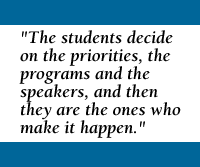
"Sue McHenry of RSS has been the lifeblood of the organization since its inception," said Glenn. He noted that other "parents" of AISES at UAF were Claudette Bradley, who was a math professor at the rural college then; Lorene Hegdal, an Inupiaq civil engineer from Nome with the Alaska Department of Transportation at the time; and John Kelley of IMS, who assisted with leadership and provided opportunities for students. One of the first AISES chapter members landed a job with Kelley in Greenland on a major ice-coring project, Glenn said.
"What I like about AISES is that it's all run by the students themselves," said Sue Hills, AISES supporter and director of Outreach Core for the Alaska INBRE. "The students decide on the priorities, the programs and the speakers, and then they are the ones who make it happen."
"I have marveled at the growth and development of the UAF AISES chapter and offer my help speaking to students whenever I can," Glenn said.
Co-president Kelly Thompson said, "To potentially interested members I would just say 'come on down and check it out.' We enjoy making new friends." The UAF AISES chapter meets every other Thursday during the academic year from 1-2 p.m. in the Brooks Building gathering room.
For more information, please contact:
- Sue McHenry, AISES advisor, Rural Student Services, (907) 474-5152 or fnsim@uaf.edu.
Useful links:
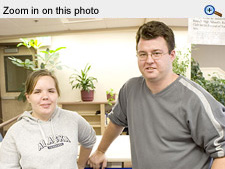
Ann Wilson and Kelly Thompson are co-presidents of the UAF chapter of AISES for 2005-06.
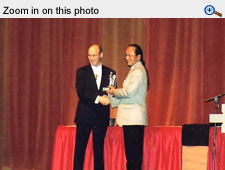
UAF alumnus Richard Glenn of Barrow, Alaska (left) received the Professional of the
Year Award from Robert Whitman, chair of the AISES board, at the 2004 national conference.
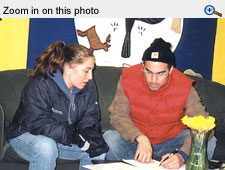
Rachel Keirn and Wily Splain work on homework together in the Brooks Building. Both
earned B.S. degrees in mechanical engineering from UAF. Keirn is now working with
DOWL Engineers and Splain is with Alyeska Pipeline Service Co.
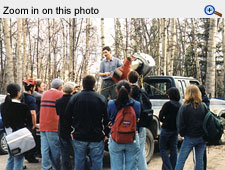
Lee DeWilde, an AISES member, 2004 student commencement speaker and winner of the
Provost's Prize, explained his senior project to modify an outboard jet engine so
it performed more efficiently during a program for students in the Alaska Native Science
and Engineering Program.
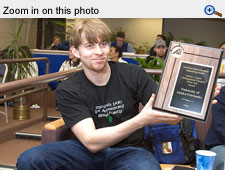
Bradley MacLeod, co-president during 2004-05, shows off the distinguished chapter
award given to the UAF chapter at the 26th annual national conference in November
2004.
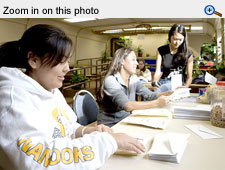 Melody Shangin, Deanna Strunk and Annie Weber stuff envelopes with letters asking
individuals and organizations to contribute to the UAF AISES chapter. Contributions
will fund scholarships, student travel to attend scientific meetings and other chapter
activities.
Melody Shangin, Deanna Strunk and Annie Weber stuff envelopes with letters asking
individuals and organizations to contribute to the UAF AISES chapter. Contributions
will fund scholarships, student travel to attend scientific meetings and other chapter
activities.
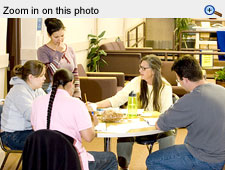 Advisor Sue McHenry (center) meets with AISES chapter officers (left to right) Ann
Wilson, Tracy Shield (standing), Minnie Goodblanket and Kelly Thompson in the Gathering
Room of Brooks Building to plan the year's activities.
Advisor Sue McHenry (center) meets with AISES chapter officers (left to right) Ann
Wilson, Tracy Shield (standing), Minnie Goodblanket and Kelly Thompson in the Gathering
Room of Brooks Building to plan the year's activities.
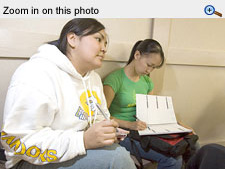
Melody Shangin (left), who is majoring in electrical engineering, and Crystal Alstrom,
a civil engineering major, take notes during an AISES meeting.
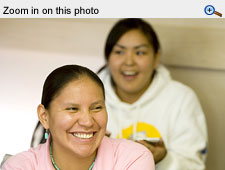
Minnie Goodblanket (left) and Melody Shangin respond with smiles during an AISES
meeting.
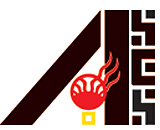
The American Indian Science & Engineering Society (AISES) is a national, non-profit
organization that nurtures building of community by bridging science and technology
with traditional Native values.


